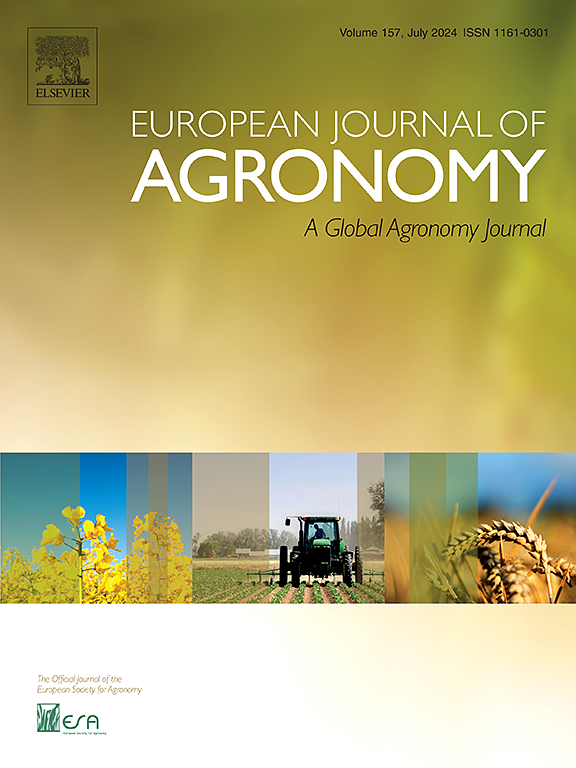Assessing the influence of environmental drivers on soybean seed yield and nitrogen fixation estimates and uncertainties in the United States
IF 4.5
1区 农林科学
Q1 AGRONOMY
引用次数: 0
Abstract
Context
Soybean [Glycine max (L.) Merr.] is one of the major crops worldwide. Identification of environmental factors that improve both yield and N2-fixation remain of high importance.
Objective
The study aimed to i) assess the effect (estimate and uncertainty) of sulfur (S) fertilization on seed yield and N2-fixation (as N derived from the atmosphere, Ndfa), and (ii) evaluate the influence of soil and weather variables on these estimates and uncertainties.
Methods
Thirty-five studies from nine US states were analyzed, comparing no fertilization (Check) with S fertilization at planting (S), using a regression tree approach to assess environmental effects on yield and Ndfa.
Results
For both treatments, precipitation from full-pod to full-seed explained 40 % of the yield variation. For the Check, [soil organic matter, SOM/(clay+silt)] was a secondary factor. For the S, seasonal precipitation above 73 mm resulted in the highest yield (4.9 Mg ha−1), with 51 % Ndfa and 135 kg ha−1 of fixed-N. Yield uncertainty, averaging 1.2 Mg ha−1, was associated with soil clay content below 11 %. Vapor-pressure-deficit from full-bloom to full-pod influenced Ndfa, accounting for 40 % of its variation between treatments. For both treatments, the highest Ndfa (∼65 %) required vapor-pressure-deficit below 0.92 kPa. Soil clay was pivotal to the uncertainty in Ndfa, explaining 34 % and 40 % of the variation for Check and S, but with a reduction in uncertainty when soil clay was above 26 %.
Conclusion
The main regulators of yield and Ndfa were precipitation, temperature, SOM, and soil texture. Sulfur fertilization moderately increased yield and Ndfa, especially in environments with high plant N-demand. Ndfa uncertainty was more related to crop growth factors, with high seed yield correlating with high Ndfa.
Implications
Future research should focus on controlled studies to improve the knowledge of the identified soil and weather factors and their interplay with seed yield and Ndfa.
评估环境驱动因素对美国大豆种子产量和固氮作用估计值及不确定性的影响
背景大豆 [Glycine max (L.) Merr.] 是全球主要农作物之一。该研究旨在:(i) 评估硫(S)肥对种子产量和 N2-固定量(从大气中提取的 N,Ndfa)的影响(估计值和不确定性);(ii) 评估土壤和天气变量对这些估计值和不确定性的影响。方法对美国九个州的 35 项研究进行了分析,比较了不施肥(Check)和播种时施 S 肥(S),采用回归树方法评估环境对产量和 Ndfa 的影响。对于 Check,[土壤有机质,SOM/(粘土+淤泥)]是次要因素。对于 S 来说,73 毫米以上的季节性降水导致最高产量(4.9 兆克/公顷-1),其中 Ndfa 为 51%,固定氮为 135 千克/公顷-1。产量的不确定性(平均 1.2 兆克/公顷-1)与土壤粘土含量低于 11 % 有关。从盛花期到结荚期的蒸汽压力不足影响了 Ndfa,占不同处理间 Ndfa 变化的 40%。在两种处理中,最高的 Ndfa(65%)需要低于 0.92 kPa 的蒸汽压力缺口。土壤粘度对 Ndfa 的不确定性起着关键作用,分别解释了检查和 S 的 34 % 和 40 % 的变化,但当土壤粘度超过 26 % 时,不确定性有所降低。硫肥适度提高了产量和Ndfa,尤其是在植物需氮量高的环境中。Ndfa的不确定性与作物生长因素关系更大,高种子产量与高Ndfa相关。
本文章由计算机程序翻译,如有差异,请以英文原文为准。
求助全文
约1分钟内获得全文
求助全文
来源期刊

European Journal of Agronomy
农林科学-农艺学
CiteScore
8.30
自引率
7.70%
发文量
187
审稿时长
4.5 months
期刊介绍:
The European Journal of Agronomy, the official journal of the European Society for Agronomy, publishes original research papers reporting experimental and theoretical contributions to field-based agronomy and crop science. The journal will consider research at the field level for agricultural, horticultural and tree crops, that uses comprehensive and explanatory approaches. The EJA covers the following topics:
crop physiology
crop production and management including irrigation, fertilization and soil management
agroclimatology and modelling
plant-soil relationships
crop quality and post-harvest physiology
farming and cropping systems
agroecosystems and the environment
crop-weed interactions and management
organic farming
horticultural crops
papers from the European Society for Agronomy bi-annual meetings
In determining the suitability of submitted articles for publication, particular scrutiny is placed on the degree of novelty and significance of the research and the extent to which it adds to existing knowledge in agronomy.
 求助内容:
求助内容: 应助结果提醒方式:
应助结果提醒方式:


